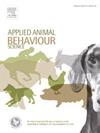Positions and movement of the tail in wild boar Sus scrofa
IF 2.2
2区 农林科学
Q1 AGRICULTURE, DAIRY & ANIMAL SCIENCE
引用次数: 0
Abstract
The wild boar Sus scrofa is widely distributed, extending from Europe into Minor, Central, and South-eastern Asia. Despite that, the biology of this species is well known, little is known about the significance of its tail position and movement. In this connection, we studied the link between tail position and movement and the corresponding behaviour as well as whether they are affected by environmental factors. The fieldwork was carried out in the spring-summer period of 2017–2018 by camera traps on the territory of two Bulgarian state hunting grounds. The total number of trap nights was 1558 and the registered videos of wild boars were 220. In the videos, 112 females, 42 males, 141 juveniles (1–2 years old) and 198 offspring were identified. Five tail positions were defined: hanging, wagging, horizontal, raised, and arched. By applying the Generalized Linear Model, it was found that Behaviour, Sex and Habitat significantly influence the tail position. The observed behaviours were divided into two main categories - active and passive. The hanging and wagging tail prevailed over the other tail positions with the tail usually hung during foraging and digging. The wagging prevailed in exploratory and amicable behaviour, and the tails were dominantly raised in cases of agonistic behaviour. During the passive behaviours, the hanging tail also prevailed. Given that wild boar is an important species for both biodiversity and hunting practices in many countries, the research done allows us to conclude that systematic camera trapping is a powerful tool for studying its behaviour, which could contribute to the management of the species.
求助全文
约1分钟内获得全文
求助全文
来源期刊

Applied Animal Behaviour Science
农林科学-行为科学
CiteScore
4.40
自引率
21.70%
发文量
191
审稿时长
18.1 weeks
期刊介绍:
This journal publishes relevant information on the behaviour of domesticated and utilized animals.
Topics covered include:
-Behaviour of farm, zoo and laboratory animals in relation to animal management and welfare
-Behaviour of companion animals in relation to behavioural problems, for example, in relation to the training of dogs for different purposes, in relation to behavioural problems
-Studies of the behaviour of wild animals when these studies are relevant from an applied perspective, for example in relation to wildlife management, pest management or nature conservation
-Methodological studies within relevant fields
The principal subjects are farm, companion and laboratory animals, including, of course, poultry. The journal also deals with the following animal subjects:
-Those involved in any farming system, e.g. deer, rabbits and fur-bearing animals
-Those in ANY form of confinement, e.g. zoos, safari parks and other forms of display
-Feral animals, and any animal species which impinge on farming operations, e.g. as causes of loss or damage
-Species used for hunting, recreation etc. may also be considered as acceptable subjects in some instances
-Laboratory animals, if the material relates to their behavioural requirements
 求助内容:
求助内容: 应助结果提醒方式:
应助结果提醒方式:


